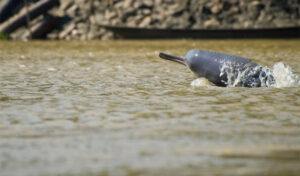By Our Correspondent
New Delhi/Lucknow, May 23: The efforts of the Uttar Pradesh (UP) government and the Namami Gange Mission directed towards cleaning the Ganga and maintaining its uninterrupted flow have led to a significant increase in the population of Gangetic dolphin in recent times. Experts have described this rise in the Gangetic dolphin population as a ‘positive environmental indicator.’
According to the Indian Wildlife Institute, there are currently about 4,000 dolphins in the Ganga and its tributaries. This indicates that the Ganga provides a favorable habitat for dolphins and that the river’s water is clean. The number of dolphins is expected to increase further in the future.
Estimates suggest that the number of Gangetic dolphins in Uttar Pradesh is expected to reach 2,000, which is more than half of the total Gangetic dolphins found in India. Therefore, the primary responsibility for their conservation and development also falls on UP.
In this regard, Uttar Pradesh has implemented a new tourism policy for the state and declared a Dolphin Sanctuary area in the Chambal Sanctuary. Currently, approximately 111 dolphins have been recorded in the Chambal region.
It is worth mentioning that since Prime Minister Modi announced Project Dolphin, public interest in this unique and rare mammal has increased. However, a significant portion of the population remains unfamiliar with this charismatic megafauna. Therefore, conserving the Gangetic dolphins will not only raise awareness about protecting this species but also enhance efforts to maintain the purity and uninterrupted flow of the Ganga.

Awareness and public participation are key aspects of the Namami Gange Mission. Based on this, the goal is set to stabilize the population of Gangetic dolphins by 2030 and double the number of more endangered species. The Clean Ganga Mission has succeeded in fostering better coordination among state governments, experts, NGOs, and local people. Through pollution reduction measures, conservation of wetlands, and efforts to improve river flow under the Namami Gange project, a suitable habitat has been provided for Gangetic dolphins.
It is noteworthy that the river dolphin is a critically endangered megafauna of the Indian subcontinent. Efforts are underway to conserve it in India. These dolphins are found primarily in the Ganga and its tributaries, including the Ramganga, Yamuna, Gomti, Ghaghara, Rapti, Son, Gandak, Chambal, and Koshi.




